|
Collecting Confederate Images
By David Wynn Vaughan
Collectors of 19th-Century photography follow the same
rudimentary and fundamental guidelines as other collecting
fields with one notable exception: subject matter. Each image is
a unique, one-of-a-kind work of art with its own set of inherent
and esoteric qualities. A long litany of considerations must be
applied before acquiring any image. What moves and motivates
one image collector may leave another cold. “In the eye of the
beholder” means more in this area than just about any other
collecting field. Most collectors of 19th-Century images collect
a subject or theme, such as famous personalities, occupational,
historical significance, military, fashion, children, animals,
outdoor views, postmortems and so on. The sky is the limit, and
the possibilities are endless.
Image collectors may also have collections within collections,
and a nuance found in an image may give birth to a new collecting
path. A fellow collector in the Northeast acquires images which
show a detailed reflection of the photographer, camera and light
source in the subject’s pupil. He was later able to identify several
photographers and studios through his extensive research. It
is very common for quality 19th -Century images to show the
silhouette of the photographer and camera, as well as the light
source, in the subject’s eye. It is possible to determine from
the example shown that the light source is from a window and
not a skylight by the positioning of the light in the sitter’s eye.
To be a successful Civil War image collector, one must have
a fundamental knowledge of the physical attributes of 19th
Century photography and be able to determine the different
photographic processes, sizes and formats, as well as understand
how they affect the value. There were numerous photographic
processes used during the Civil War, some of which could look
similar to the untrained eye. (Below is a brief summery of the
most popular processes and their corresponding sizes.) For
instance, a half plate tinted tintype of a Confederate officer is
much rarer and more valuable than a 1/9 plate ambrotype of a
Federal enlisted man. Add a weapon or two, and the desirability
increases significantly.
|
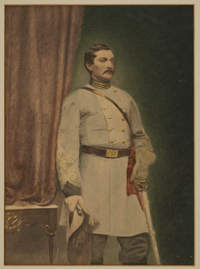
|
|
Large format tinted albumen print by Matthew Brady,
Washington, D.C.. studio of Harry Gilmore, Captain 12th Virginia Cavalry &
later Colonel 2nd Maryland Cavalry. |
½ plate tintype of Private Thomas Holeman, Company
C, "The Secession Guards," 13th Regiment Tennessee Infantry, Army of
Tennessee, C.S.A. Note that Thomas and James Holeman are brothers. |
Equally important to the physical attributes are the
following criteria which help to further determine the merit and
collectability of an image.
Condition, Condition, Condition. Is the image in exceptional
shape, free of scratches, bends, breaks, and deterioration?
Clarity and Contrast. Is the image sharp and in focus; is the
lighting strong, rendering good tonality, or is the image faded?
Content. What is the subject matter? Is the soldier in uniform,
with weapons and equipment; is he Union or Confederate?
Rarity. With what state, regiment and company did he serve;
is he identified; is the soldier heavily armed; was he killed or
wounded; is the image an outdoor scene; is there more than one
person in the image; or does other historical material accompany
the image, such as letters, personal effects, etc.?
Provenance. The origins of an image. Does it come with documentation or straight from the
family?
Subject matter is what interests most
image collectors, and it is the most
subjective. Exceptional Confederate
images, identified Confederates from
Georgia, and exquisitely-tinted Civil
War images are my collecting focus.
An in-depth knowledge of period Civil
War uniforms, insignia and weapons is
imperative to draw from when collecting
Civil War subject matter. Most purchases
take place at antique shows or auctions
without the aid of research and reference books, so it is important to understand
and master the particulars of any subject
matter.
Another key component of collecting
is sharing information and networking
with fellow collectors. This is the one
area that many new collectors seem to
overlook. When I first began collecting
Civil War images almost 25 years ago, I
networked with many advanced image
collectors and met many seasoned
veterans of the field. Most of them had
collected for 25 to 30 years so their depth
of knowledge was vast. In turn, they had
mentored under some of the original
Civil War image collectors so I figured
I learned and captured 40 to 60 years
of proprietary
information from
these icons.
Combine
the physical
elements, the
collecting criteria
outlined above,
subject themes,
and the oratory
information
passed on by
experts in the field to any other area of antique collecting
and you will be on your way to a lifetime
of learning, enjoyment and building a world class collection.
The Most Popular Photographic
Processes Used During The
Civil War
Albumen Print. A positive paper
photograph produced from a collodion
glass negative. The print was made from
thin, high-quality paper coated with the
whites of chicken eggs and salt. When
dried, the coated albumen paper print was
rendered light sensitive by floating it in a
solution of silver nitrate. The sensitized
paper was then exposed to sunlight for
development, fixed, washed and often
toned with a solution of gold chloride.
The finished photograph was commonly
applied to thin card stock.
Ambrotype. Also called the “wet plate” process, a glass plate was coated with
collodion, a sticky liquid made from
guncotton and ether. The moist, sticky
glass surface was flowed with silvernitrate,
making the plate light sensitive.
The sensitized plate was then placed in
the camera and exposed to light through
the lens. When processed, the glass
plate was an underexposed. or “thin”
negative, which optically rendered
a positive when backed by a coating
of blackened varnish, or other dark
material. Later ambrotypes were made
on dark ruby, or amethyst-colored glass.
Similar to its cousin, the tintype, both
processes were the preferred choice
of photographers for making portraits
during the Civil War. Discovered
in 1851 by Frederick Scott Archer and
Peter Wickens Fry of England, the wet
plate process was improved upon in 1854
by an American, James Ambrose Cutting
of Boston, who named it the ambrotype, after the Greek word ambrotos, or
immortal. The ambrotype did not see
widespread use until about 1859 when it
quickly replaced the more expensive and
difficult-to-produce daguerreotype.
Carte de Visite. French for “visiting
card” and commonly referred to as a
“CDV” by collectors, this was a paper
photograph produced from a glass-plate
negative, most commonly on albumen
photographic paper, and mounted onto
card stock measuring 2 1/2 by 4 1/4
inches. Often made by a special camera
with multiple lenses, an unlimited
number of inexpensive prints could be
produced from a single negative. Cartes
de visite could be ordered by the dozen
if desired.
Invented by the French photographer
Adolphe-Eugene Disderi in 1854, this type of photograph did not gain
widespread popularity in America
until about 1860 and caused the birth
of the photographic album. Many
photographers applied their logos to
the backs of CDVs, providing valuable
clues as to the locale of the photograph’s
origin.
Daguerreotype. The first commerciallysuccessful
form of photography, a
unique, positive image was produced on
a highly-polished, silver-coated copper plate. The plate was made light-sensitive
by fuming it with iodine and bromine.
Exposed to light in the camera, the plate
was then developed by the fumes of
heated mercury and often toned with a
solution of liquid gold-chloride.
The invention of the daguerreotype
was collaboration between Joseph
Nicephore Niepce and Louis Jacques
Mande Daguerre in Paris, France. The
process was introduced by the French
government in 1839 bearing Daguerre’s
name and arrived in America later the
same year. Very few daguerreotypes were
produced during the Civil War because
they were difficult and expensive to produce, and easier and more affordable
photographic processes had been
introduced.
Salt Print. Salted paper photographs
were introduced about 1854, which
were sometimes made during the early
Civil War years to record battlefield
scenes and portraits. Thin, high-quality
paper was impregnated with a solution
of ordinary salt dissolved in water then
dried, and like the albumen print, made
light sensitive with a solution of silver
nitrate. The prints were made from glass
plates or paper negatives, developed by
sunlight, fixed and washed, and were
often mounted on board stock.
Tintype. Also a wet plate process and
often referred to during the 1860s as a
melainotype (Greek for black) or ferrotype
(Latin for iron), this kind of photograph
later became commonly known as the
tintype, although the metal plate upon
which it was produced contained no tin.
The tintype is identical in process and
appearance to the ambrotype, except that
a metal plate was used instead of glass.
A blackened, or “Japanned,” sheet iron
plate was coated with collodion, the plate
sensitized with silver nitrate, exposed
to light, developed, fixed and washed.
A unique, positive photographic image
was produced on the surface of the plate.
Tintypes enjoyed immense popularity
during the Civil War because they could be easily sent through the mail.
They are often found housed
in cases like ambrotypes and
daguerreotypes or mounted in
paper mats.
Common Civil War Era
Photograph Sizes
Whole plate: 6 ½ x 8 ½
inches
Half plate: 4 ½ x 5 ½ inches
Quarter plate: 3 ¼ x 4 ¼
inches
Sixth plate: 2 ¾ x 3 ½ inches
Eighth plate: 2 1/8 x 3 ¼
inches
Ninth plate: 2 x 2 ½ inches
Sixteenth plate: 1 3/8 x 1 5/8
inches
Gem: 7/8 x ¾ inches
Carte de Visite: 4 ¼ x 2 ½
inches
------------------------------
David Wynn Vaughan
lives and works in Atlanta
with his wife Debbie and son
David. He is a graduate of
UGA and recently served as
the President of the Civil War
Round Table of Atlanta (2006-
2007), the second oldest round
table in the country.
Because of David’s willingness to loan and share
his images with others, they
have appeared in numerous
books and publications such
as: Time Life’s Voices of
the Civil War series, Great
Photographs of the Civil
War; National Geographic’s
Eyewitness to the Civil War
and The Civil War Atlas; The
University of Arkansas Press’s
Portraits of Conflict series;
Mercer Press’ Joe Brown’s Pets;
Faces of the Confederacy; The
Georgia Historical Quarterly,
Spring and Summer 2005
editions; to name a few.
The Southern Museum
of Civil War and
Locomotive History, a
Smithsonian affiliate, most
recently produced an exhibit
which featured 70 selected
images from his collection
and is now available for
travel for the next five years,
“Portraits in Gray, a Civil War
Photography Exhibition.” For
more information visit: www.southernmuseum.org/exhibits_travelingexhibits.htm.
Mr. Vaughan can be contacted
at: davidwvaughan1@aol.com.
|
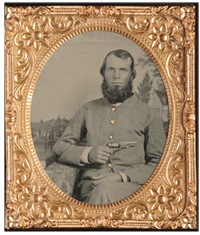
1/6
plate ambrotype by unknown
photographer of unidentified
North Carolina private
holding a revolver across
his chest.
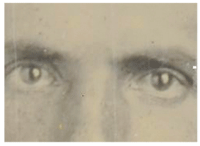
Close
inspection of the eyes
shows the light source
(a window) and the photographer
and camera.
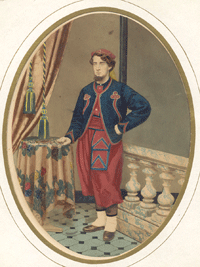
Expertly-tinted Albumen print by unknown
photographer of an unidentified member of the 5th New York Infantry
“Duyrees Zouaves."
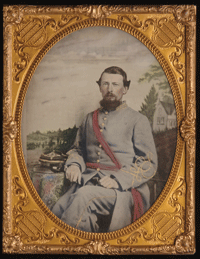
Captain James Holeman - Co. A, 24th NCT - 1/2 plate tinted ambotype.
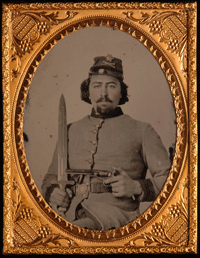
Private Franklin Ammons -
1st TN Heavy Artillery 1/4 plate ambrotype.
|